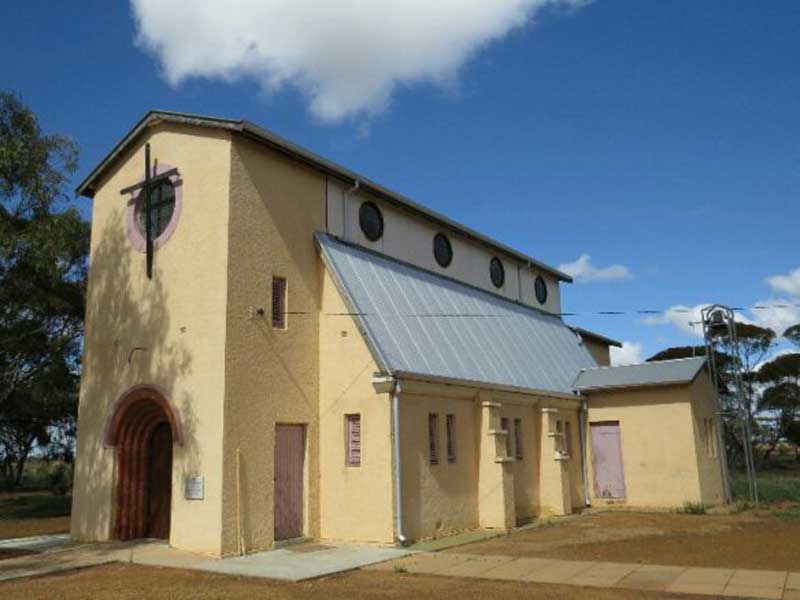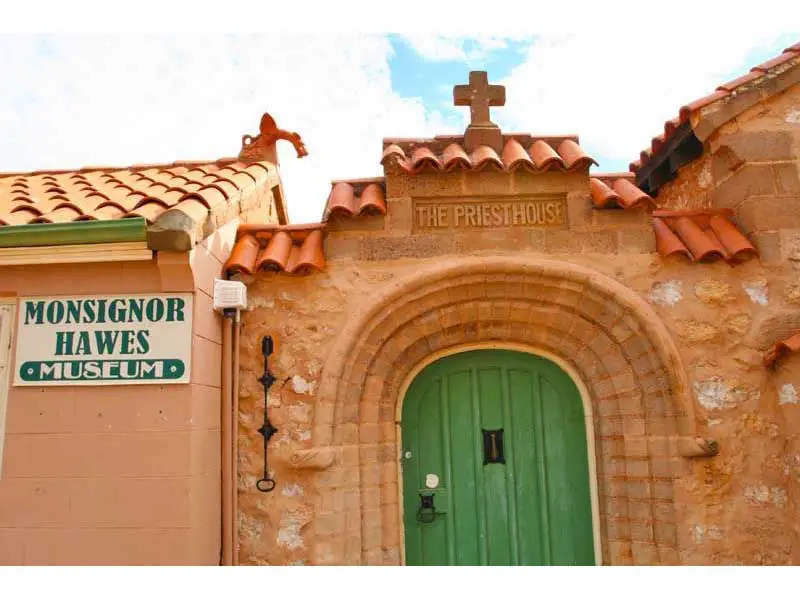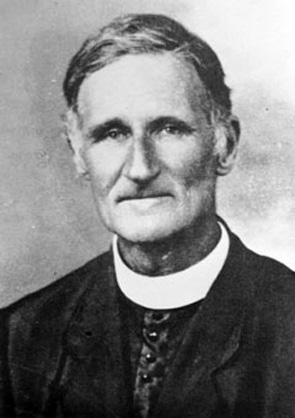Monsignor Hawes Heritage Trail takes you on a three day self-drive tour of 15 buildings created by 19th century architect and Catholic priest Monsignor John Hawes. The trail will give you an appreciation of the significant role this remarkable man played in the development of this region. Note: these are just some of the many buildings designed by Monsignor Hawes in the Central Agricultural and Wheatbelt region of Western Australia. Details of all architectural works by Monsignor Hawes can be found at Monsignor Hawes HeritageMonsignor Hawes Heritage.
Day 1: Perth to New Norcia
(130 kilometres/2 hours)
New Norcia, Australia’s only monastic town, is your first stop along the Monsignor Hawes Trail. This peaceful place is home to a community of Benedictine monks and famous for its Spanish architecture and collection of religious art works, not to mention gourmet breads and olive oil. Check out the Museum and Art Gallery, take a walking tour and enjoy a cooling drink on the wide verandah of the New Norcia Hotel.
Accommodation options: Stay overnight in the hotel, or check in to the quiet retreat of Monastery Guesthouse.
 Church of Saint Joseph, Perenjori
Church of Saint Joseph, Perenjori
Day 2: New Norcia to Morawa
(370 kilometres/4 hours)
Join the monks in prayer before heading north to Moora, stopping to take in local heritage architecture on the Moora Town Walk. Wildflowers colour the drive to Carnamah during spring. Enjoy lunch here before travelling on to Perenjori to see the Monsignor Hawes-designed Church of Saint Joseph. Perenjori is also home to the famous and unique Wreath Leschenaultia which flowers during September and October. Continue to Morawa and visit the Church of the Holy Cross, also designed by Monsignor Hawes.
 Church of the Holy Cross
Church of the Holy Cross
Catholic Church of the Holy Cross, Davis Street, corner Dreghorn Street, Morowa: the is constructed of locally quarried stone with a Swiss Pattern terracotta tiled roof with a small adjoining presbytery built of local stone with a Pantile style terracotta tiled roof about 20 metres to the west of the church, both designed in an Inter-War Romanesque style. Monsignor Hawes also supervised its construction in 1933.
Accommodation options: Hotel/motel, caravan park and farm stays.
 Dominican Chapel of St Hyacinth, Yalgoo
Dominican Chapel of St Hyacinth, Yalgoo
Day 3: Morawa to Geraldton
(350 kilometres/4 hours)
Drive north to historic Yalgoo and admire its well-preserved colonial architecture and rich gold mining heritage. Spend time exploring the museum, Court House and Dominican Chapel of St Hyacinth, designed by Monsignor Hawes.
Dominican Chapel of St Hyacinth, Henty Street, Yalgoo: The building is constructed of random rubble stone and has a tiled roof. It has arched openings and two buttreses at the rear. Set on stone foundations is a large shingled bell tower with a corrugated iron roof. From Yalgoo, head west towards the coast, stopping at Mullewa’s beautiful Monsignor Hawes church on the way to Geraldton. Monsignor Hawes was based in Geraldton, working as a pioneer priest and architect in the diocese between the great wars. One of his most important buildings is located in the port city, the St Francis Xavier Cathedral.
 The Priests House, Bowes St, Mullewa
The Priests House, Bowes St, Mullewa
The Priests House, Bowes St, Mullewa: Originally the home of Monsignor J C Hawes while he was parish priest at our Lady of Mount Carmel (Roman Catholic) Church, it was largely built by his own hands. the house was constructed with stone walls, Cordova tiles and some stained glass windows. Stonework is unrendered with square cut corner stones. Heavy concrete verandah columns form a colonade to link the church and the priest’s house.
 Our Lady of Mount Carmel and St Peter & St Paul Catholic Church, Mullewa
Our Lady of Mount Carmel and St Peter & St Paul Catholic Church, Mullewa
Our Lady of Mount Carmel and St Peter & St Paul Catholic Church, Doney St, Mullewa: This stone building of markedly ecclesiastical style is recognised as the most significant Church designed by Monsignor Hawes. It was largely built with his own hands when he was parish priest at Mullewa.
 St Francis Xavier Catholic Cathedral, Geraldton
St Francis Xavier Catholic Cathedral, Geraldton
St Francis Xavier Catholic Cathedral, Cathedral Av, Geraldton: The largest and most important of a group of churches designed and in some cases built by Monsignor Hawes in the Geraldton diocese. As a group they display an eclectic style, personal to Hawes and one both architecturally and liturgically significant. The Cathedral is constructed of random rubble stone and has a tiled roof. It has arched openings and two buttreses at the rear. Set on stone foundations is a large shingled bell tower with a corrugated iron roof. It is built in the style of Spanish colonial, a variation of Baroque. Many periods of architecture are represented; a huge dome which covers octagonal space between nave and chancel. Other features include round windows in octagonal walls, octagonal twin dome towers at west end, and a great central portal. The round arches of nave are supported on squat, unfluted bulky columns.
If you have your camping gear or caravan in tow, check out the range of caravan parks and camping sites available in Australia’s Golden Outback. For additional information about the Monsignor Hawes Trail, contact the local visitor centres.

About Monsignor Hawes
John Cyril Hawes was born September 7th, 1876 in Richmond, England. In his early life and schooling at King’s School in Canterby John Hawes is described as a quiet but effective student. It was evident he had a flair for visual art and in 1893 upon completing his schooling Hawes commenced an architectural ‘apprenticeship’ in a London commercial architect firm. During this time he also learned several other art forms including sculpture and stained glasswork.
John Hawes life and work as an architect and within the Christian faiths were always entwined. One of his first commissions was an Anglican Church in Northumberland. It was through this project that Hawes came to study for the priesthood and in 1903 he was ordained as an Anglican Deacon in St Paul’s Cathedral, London.
At the age of thirty two Hawes commenced a short period of missionary work in the Bahamas where, in addition to acting as a minister, he was charged with the task of repairing several hurricane damaged churches. Struggling with personal conflict over his religious direction, Hawes left the Bahamas after just one year and began his journey with Catholicism. Hawes converted to Catholicism in New York in 1911. Just four years later he was ordained a Catholic Priest in Rome.
The most productive architectural period of his life was spent in the Mid West of Western Australia in the first half of the 20th century. Hawes arrived in Western Australia at the beginning of November 1915. He spent his first summer in the Murchison travelling first to cue in the very hottest part of the year. In a letter home to England he described the climate as far too hot to do anything except “flop around struggling to exist”. The following year he was recalled to Geraldton to begin work on St Francis Xavier Cathedral. The first stage of the cathedral was completed in 1918 but following the death of Bishop Kelly work was halted. Work did not recommence until 1926 and it was another twelve years before the magnificent cathedral was completed an officially opened.
During his time in the Mid West, Hawes was responsible for an astounding body of work throughout the region. His creations ranged from basic corrugated iron structures like St Patrick’s church in Wonthella Geraldton, to the unique design of Our Lady of Mt Carmel in Mullewa or the grand structure of Nazareth House Convent perched on the edge of Champion Bay in Geraldton. There is little doubt that Hawes’ work in the region has contributed, and will continue to contribute to the vibrancy of the local build landscape. He designed a small cottage, the hermitage, adjacent to the new St John of God Hospital in Geraldton. Hawes declared the building, completed in 1936, was to be his retirement home. However, in 1939 Monsignor Hawes left for Cat Island in the Bahamas, never to return. He lived out his life as a hermit, and died on June 26th, 1956 in Miami, Florida aged 79.
Design by W3Layouts | Content © 2013 Phoenix Group Co. | Sales: phone 1300 753 517, email: [email protected]

